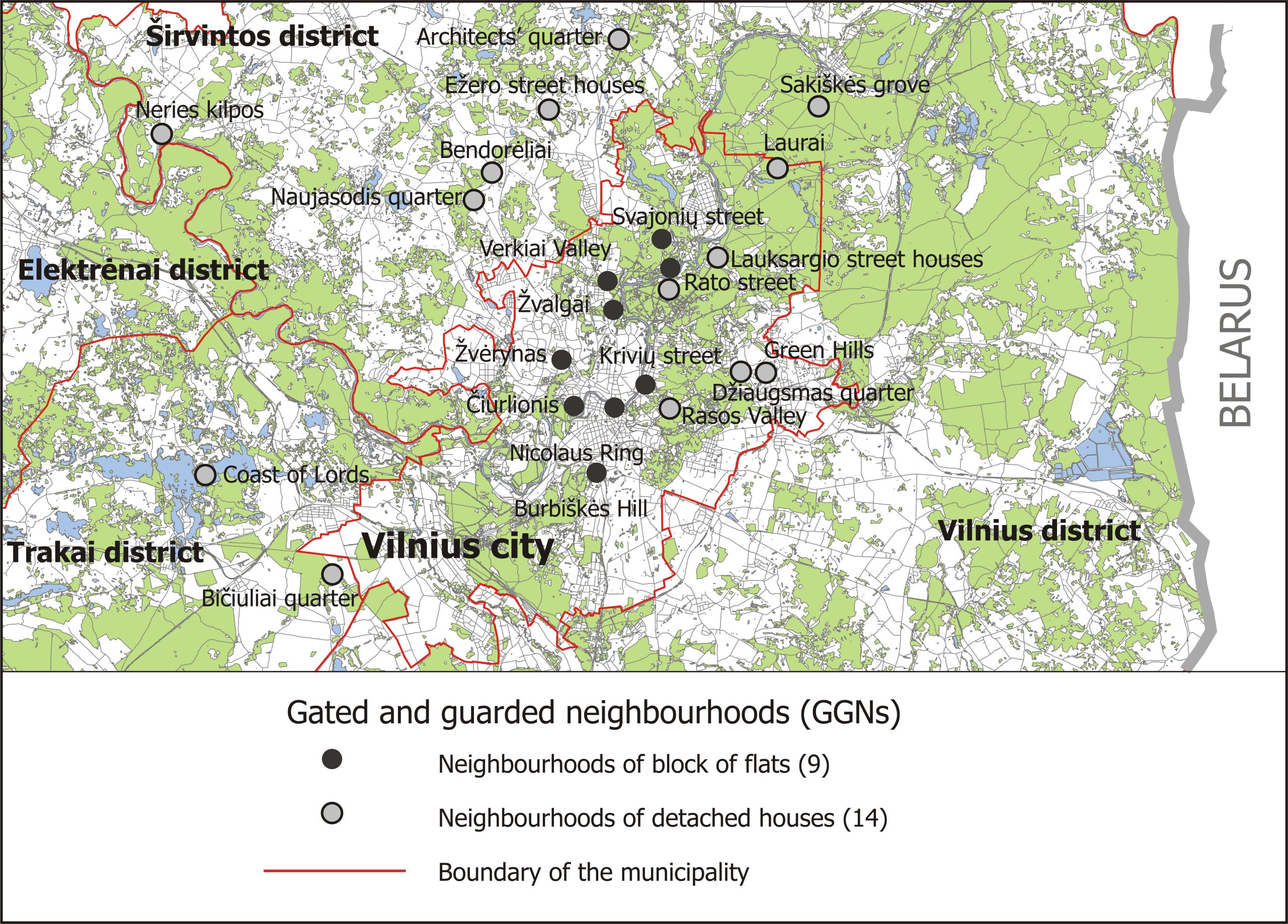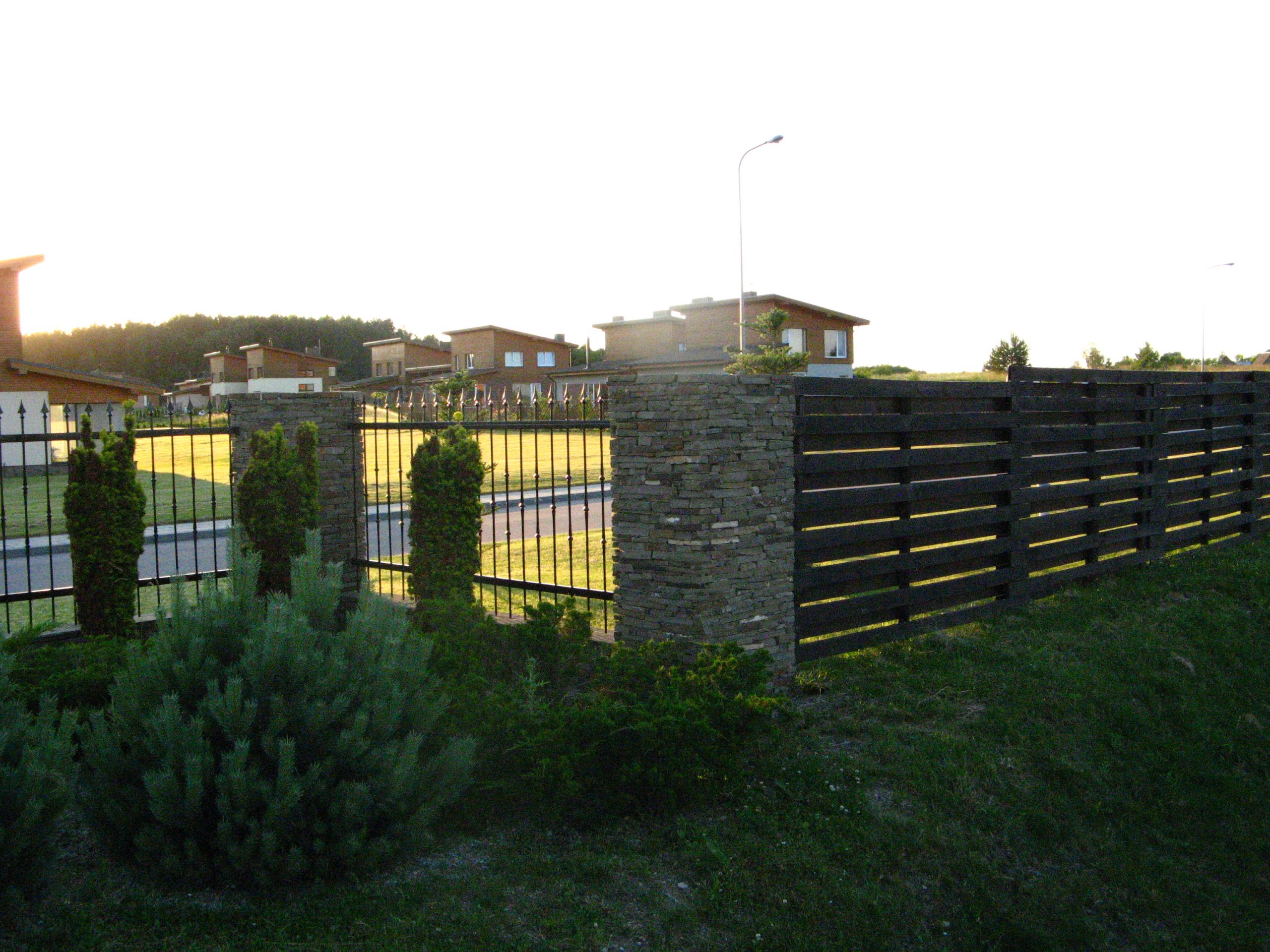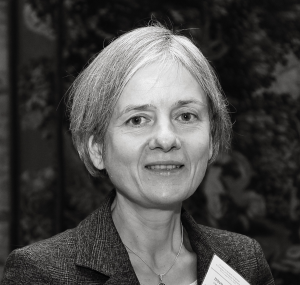20
Gintarė Pociūtė-Sereikienė, Lithuanian Social Research Centre; Dovilė Krupickaitė, Vilnius University, and Laura Peciukonytė, Public Policy and Management Institute Group, Lithuania
In this blog we present our research results on gated neighborhoods in Lithuania (with particular emphasis placed on the Vilnius region) which has been previously published as a journal article in Hungarian Geographical Bulletin 63(3) 2014 and can be found here.
Development of a socially sustainable city is not an easy task especially in the context of socio-spatial residential differentiation. One of the examples of such differentiation is the desire of residents to flock into the “social ghettos” – gated and guarded neighborhoods (GGNs). This research is focused on gated communities that are located in Lithuanian capital Vilnius and its surroundings.
The analysis of the literature highlighted that gated and guarded neighborhoods have been increasing in most European countries, including those where this form of housing had been rare until the 1990s. However, the appearance of GGNs in Lithuania, compared to other post-socialist countries (for example the Czech Republic, Hungary, Poland, or Russia) was late. The idea for such development of neighborhoods in Lithuania came from abroad. The first GGN in Lithuania appeared at the beginning of the 21th century and became popular in the middle of the first decade. This period coincided with the country’s robust economic growth and a real-estate boom.

Our survey in 2010 showed that around 25% of newly built neighborhoods with detached or semi-detached houses in Vilnius region were gated and guarded. Figure 1 shows the locations of GGNs in Vilnius region.
In our research we chose “Neries kilpos” gated neighborhood for a detailed case study, because its characteristics (size, security installations, socio-economic status) are very typical of other Lithuanian GGNs. “Neries kilpos” is well secured by fences (Photo 1). There are also automatic gates and video cameras. Furthermore, the whole territory is supervised by the territory manager on workdays.

During our research we analysed different actors’ motivations regarding the development of gated neighborhoods in the Vilnius region: the motivations of developers and the motivations of residents. Additionally, in order to understand the market demand, we analysed the advertisements that presented such type of neighborhoods in Lithuania.
Therefore, the detailed analysis of advertisements of gated neighborhoods revealed that comfort, quality and “fascinating” exclusive landscape were unanimously emphasized. The geographical location in the urban region was another important factor, which was followed by the prestige of the settlement. Regarding the security aspect, the real estate advertisements underlined not only property protection but also the granting of more privacy.
Our research and discussions with “Neries kilpos” GGN residents revealed that exclusive landscapes and attractive places for recreation were the most important motives that inspired the respondents to choose the settlement. The most important aspects for the residents living in such neighborhoods are the community, assurance of safe social environment, economic profit, the lack of control compensation and maintenance of the settlement.
The conclusions that we made were as follows: the fences around GGNs are a symbol of the border which determines a safe and united space. It also provides physical security for children. As a result, the investors tend to create an image of GGNs as safe, and more comfortable residential areas. As the maintenance of security is quite expensive, only a small part of GGN residents want to invest in them.
However, some differences between Lithuanian and foreign gated communities can also be pointed out. Firstly, the development of GGNs in Lithuania started later than in other post-socialist countries, and they did not receive such popularity as in Russia, Poland, Hungary, and the Czech Republic. Also, there are almost no manifestations of luxury. These settlements are not exclusively prestigious as they are inhabited by upper middle social layer residents. The residents usually chose these settlements not because to be surrounded by rich neighbors, but because in such settlement “everything is done for sake of people, not for money (male resident from “Neries kilpos”). The development of GGNs in Lithuania differs from the tendencies in other post-socialist countries, and it is more similar to the trends of countries where such forms of living are not very popular (e.g. Spain, France).
Yet, the idea to live in a small closed community with people of similar status and to enjoy the beauty of the environment is becoming more and more attractive as well. As our case-study showed, residents of such neighborhoods wanted to realize some of these ideals. Moreover, children also play an important role; their safety regularly comes to the fore. As people lack social safety and control in the chaotic outside world, such neighborhoods are providing an alternative with their safe and ordered landscapes.
Author Biographies
 Gintarė POCIŪTĖ-SEREIKIENĖ is the geographer working as researcher at Lithuanian Social Research Center (LSRC) Institute of Human Geography and Demography. Her academic research interests encompass regional and urban geography, spatial polarization, peripheralisation, post-transition period in Lithuania and CEE countries. Last year she has obtained Doctor degree at Vilnius University (and Nature Research Center). She has defended PhD thesis under the title “Spatial structure of peripherality in Lithuania”. Gintarė has experience not only in scientific field as for a while she has been working in Brussels in EU institution Committee of the Regions. She is an author and co-author of 14 scientific publications. Also, she participates in national and international projects, seminars and workshops. She is the member of the Board of Lithuanian Geographical Society. She is also responsible for administrative affairs of scientific journal “Geographical Yearbook”. Contact email: gintarei.pociutei@gmail.com.
Gintarė POCIŪTĖ-SEREIKIENĖ is the geographer working as researcher at Lithuanian Social Research Center (LSRC) Institute of Human Geography and Demography. Her academic research interests encompass regional and urban geography, spatial polarization, peripheralisation, post-transition period in Lithuania and CEE countries. Last year she has obtained Doctor degree at Vilnius University (and Nature Research Center). She has defended PhD thesis under the title “Spatial structure of peripherality in Lithuania”. Gintarė has experience not only in scientific field as for a while she has been working in Brussels in EU institution Committee of the Regions. She is an author and co-author of 14 scientific publications. Also, she participates in national and international projects, seminars and workshops. She is the member of the Board of Lithuanian Geographical Society. She is also responsible for administrative affairs of scientific journal “Geographical Yearbook”. Contact email: gintarei.pociutei@gmail.com.
 Dovilė KRUPICKAITĖ is the geographer working as the professor at Vilnius University Department of Geography and Land Management. Her academic research interests encompass population, urban and regional geography, demography, urbanization studies, planning of regions and cities. Dovilė is the author and co-author of more than 30 scientific publications in various scientific journals and monographs. She is one of the authors’ who prepared maps for National Atlas. She is the leader and participant of national and international projects. Dovilė is the president of the Lithuanian Geographical society. Contact email:dovile.krupickaite@gf.vu.lt
Dovilė KRUPICKAITĖ is the geographer working as the professor at Vilnius University Department of Geography and Land Management. Her academic research interests encompass population, urban and regional geography, demography, urbanization studies, planning of regions and cities. Dovilė is the author and co-author of more than 30 scientific publications in various scientific journals and monographs. She is one of the authors’ who prepared maps for National Atlas. She is the leader and participant of national and international projects. Dovilė is the president of the Lithuanian Geographical society. Contact email:dovile.krupickaite@gf.vu.lt
 Laura PECIUKONYTE is researcher at Public Policy and Management Institute (PPMI Group). Her academic research interests encompass early childhood education, VET, adult education, social inclusion, EU policies and development of cities topics. Laura has obtained Master’s degree of European Studies in Institute of International Relations and Political Science Vilnius University. She has experience in working with multi-national expert teams and works with international and national level clients and is good in applying various qualitative and quantitative research methods.Contact email: laura.peciukonyte@yahoo.com
Laura PECIUKONYTE is researcher at Public Policy and Management Institute (PPMI Group). Her academic research interests encompass early childhood education, VET, adult education, social inclusion, EU policies and development of cities topics. Laura has obtained Master’s degree of European Studies in Institute of International Relations and Political Science Vilnius University. She has experience in working with multi-national expert teams and works with international and national level clients and is good in applying various qualitative and quantitative research methods.Contact email: laura.peciukonyte@yahoo.com
